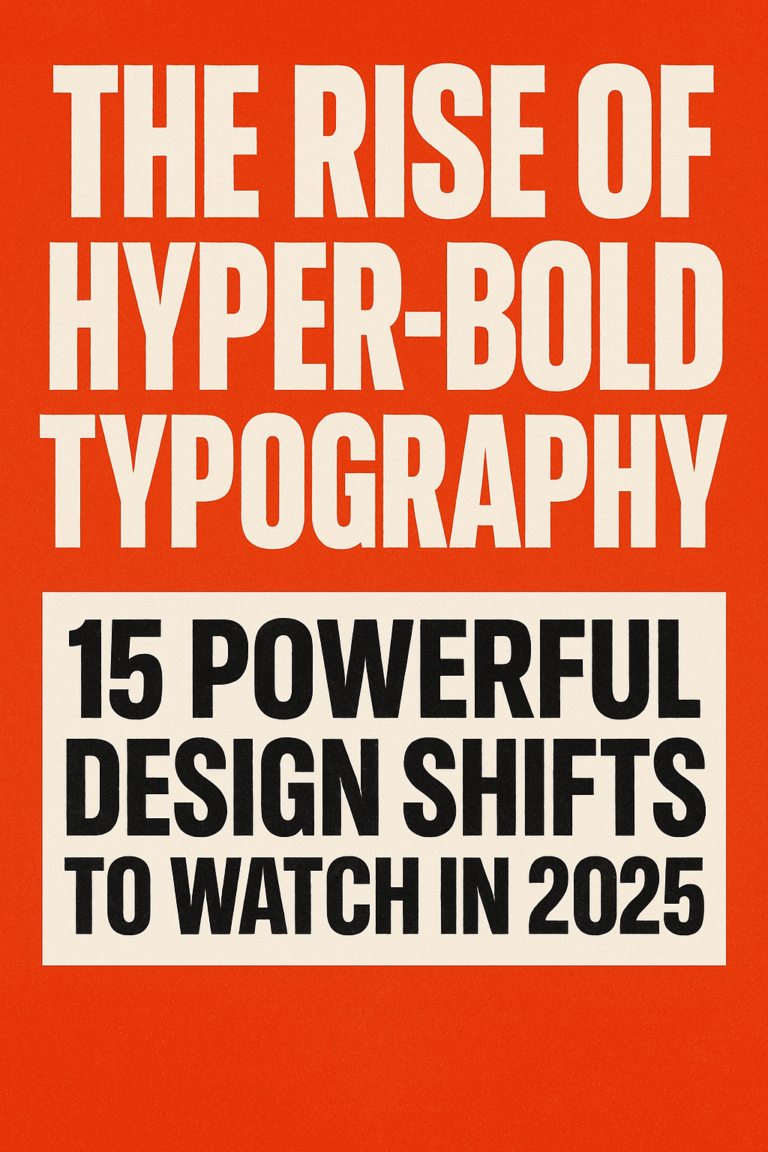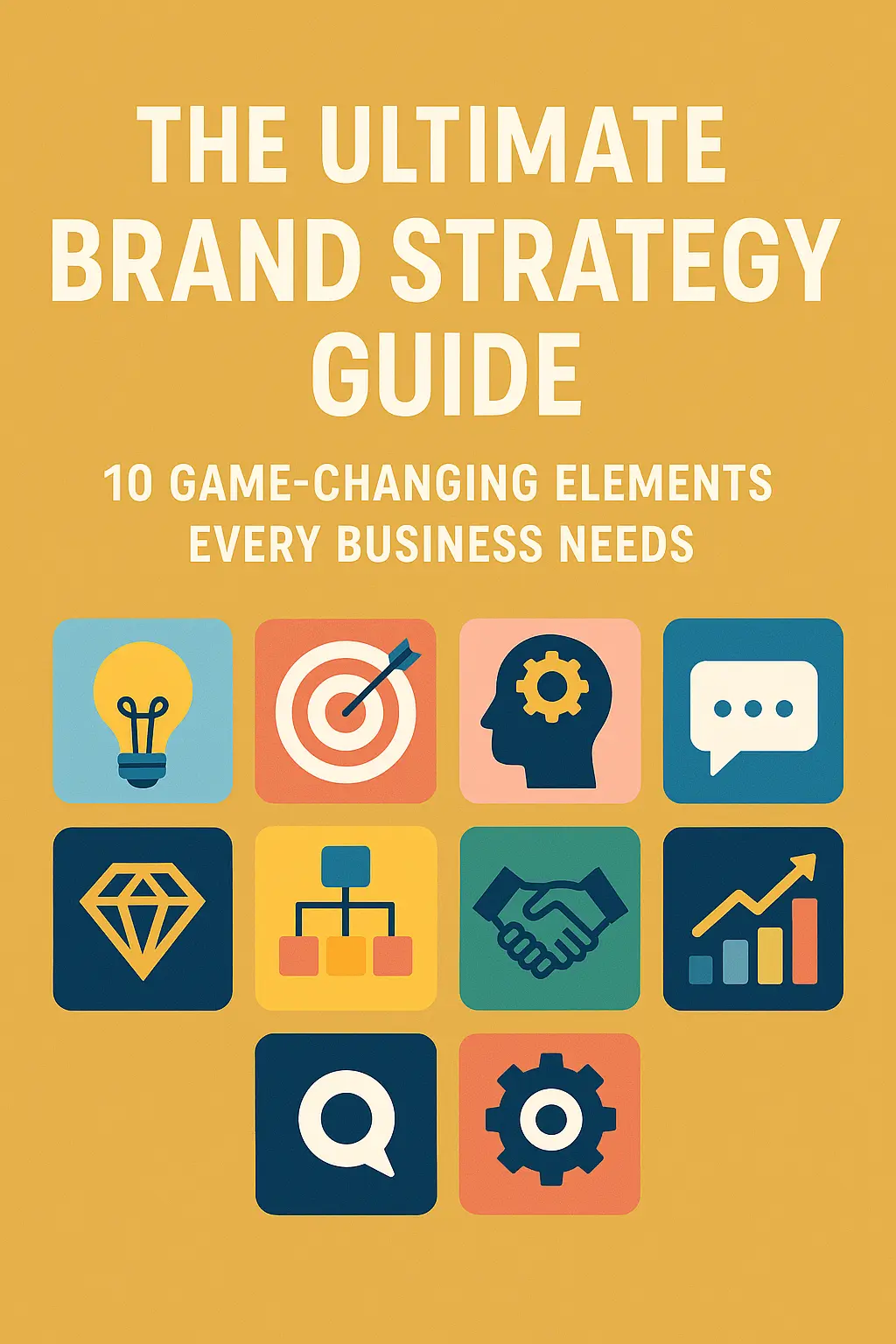
Picture this: You’re scrolling through your phone, and within seconds, you can identify a Nike ad without even seeing the logo. That swoosh isn’t just a symbol—it’s the result of decades of strategic brand building. But here’s the kicker: you don’t need decades or Nike’s budget to create a brand that sticks.
Whether you’re launching your first startup or trying to revitalize an existing business, understanding brand strategy isn’t just nice-to-have anymore—it’s survival. In today’s crowded marketplace, businesses without a clear brand strategy are like ships without compasses, drifting aimlessly while their competitors sail past them.
I’ve seen countless entrepreneurs pour their hearts (and bank accounts) into products that never gained traction, simply because they skipped the foundational work of brand strategy. Don’t let that be you.
What Exactly Is Brand Strategy (And Why Everyone Gets It Wrong)
Let me clear up the biggest misconception right away: brand strategy isn’t just about logos and color schemes. Those are brand identity elements—important, yes, but they’re just the tip of the iceberg.
Brand strategy is your master plan for making your business memorable, trustworthy, and irresistible to your ideal customers. It’s the blueprint that guides every decision, from your website copy to your customer service approach.
Think of it like this: If your business were a person at a party, brand strategy would determine their personality, values, and conversation style. Brand identity would be their outfit and hairstyle. Both matter, but personality creates lasting relationships.
Here’s what separates winning brands from forgotten ones:
- Clarity of purpose: They know exactly why they exist beyond making money
- Consistent messaging: Every touchpoint reinforces their core message
- Emotional connection: They make customers feel something meaningful
- Strategic positioning: They own a unique space in customers’ minds
1. Brand Positioning: Claiming Your Unique Territory
Brand positioning is like claiming your spot in the customer’s mental real estate. It answers the crucial question: « Why should I choose you over everyone else? »
The most successful brands don’t try to be everything to everyone. Instead, they become the obvious choice for a specific group of people with specific needs.
Take Dollar Shave Club. They didn’t try to compete with Gillette on features or innovation. Instead, they positioned themselves as the no-nonsense, affordable alternative for guys tired of overpaying for razors. Brilliant positioning led to a $1 billion acquisition.
Your positioning should include:
- Target audience definition
- Unique value proposition
- Competitive differentiation
- Brand promise
| Brand | Position | Why It Works |
|---|---|---|
| Volvo | Safety-first luxury | Owns the safety category in automotive |
| Apple | Premium innovation | Commands price premiums through perceived value |
| Southwest | Low-cost, friendly travel | Clear differentiation from traditional airlines |
Insert image of brand positioning map showing competitive landscape here
2. Brand Identity: Making Your Mark Visually
While brand identity isn’t everything, it’s often the first impression you make. Your visual identity should reflect your brand’s personality and appeal to your target audience’s aesthetic preferences.
Core brand identity elements include:
- Logo and brand mark
- Color palette
- Typography system
- Photography style
- Graphic elements and patterns
Here’s what many businesses miss: consistency across all touchpoints. Your brand should look cohesive whether someone encounters you on Instagram, your website, or a business card.
Tools like Adobe Creative Cloud and Canva for Teams make professional design accessible, but remember—good design isn’t just about looking pretty. It’s about communicating your brand’s essence instantly.
3. Brand Architecture: Organizing Your Brand Portfolio
For businesses with multiple products, services, or target markets, brand architecture becomes crucial. It’s your organizational system that defines how different brand elements relate to each other.
Three main approaches:
- Monolithic: One master brand covers everything (like Google)
- Endorsed: Sub-brands supported by master brand (like Marriott hotels)
- Freestanding: Independent brands under one company (like P&G)
The right architecture depends on your business goals, target audiences, and market dynamics. Many startups begin with monolithic architecture for simplicity, then evolve as they grow.
4. Brand Development Process: Building Brick by Brick
Creating a brand strategy isn’t a weekend project—it’s a systematic process that requires research, strategic thinking, and careful execution.
The proven brand development framework:
Phase 1: Discovery and Research
- Market analysis and competitive landscape
- Target audience insights and personas
- Internal stakeholder interviews
- Brand audit of existing assets
Phase 2: Strategy Definition
- Brand positioning and messaging platform
- Visual identity system development
- Brand voice and tone guidelines
- Implementation roadmap
Phase 3: Implementation and Launch
- Asset creation and production
- Team training and guidelines
- Launch campaign planning
- Performance measurement setup
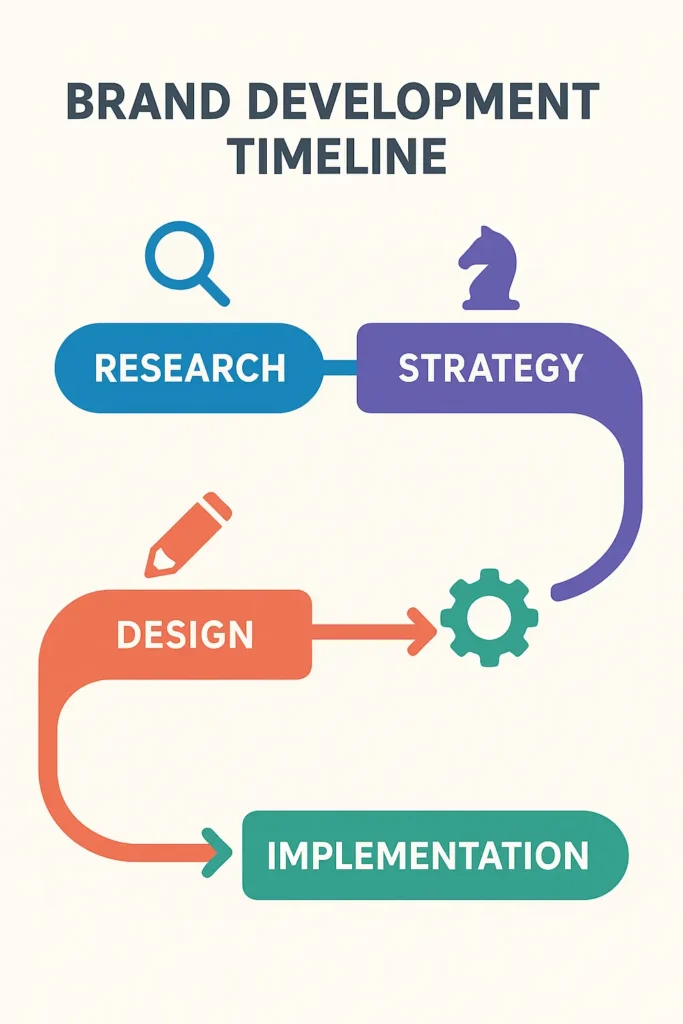
5. Digital Brand Strategy: Winning Online
Today’s brand strategy must be digital-first. Your online presence isn’t separate from your brand—it IS your brand for most customers.
Digital brand strategy essentials:
- Website optimization: Your digital headquarters should reflect your brand perfectly
- Social media consistency: Each platform should feel authentically you
- Content marketing: Share valuable content that reinforces your positioning
- SEO integration: Use tools like SEMrush to ensure brand visibility
The beauty of digital branding is its measurability. Tools like Google Analytics and Brand24 help you track brand performance and sentiment in real-time.
Remember: digital brand strategy isn’t about being everywhere—it’s about being meaningfully present where your audience spends time.
6. Brand Management: Keeping Everything Aligned
Building a brand is hard; maintaining it consistently is harder. Brand management ensures every team member, vendor, and partner represents your brand correctly.
Essential brand management practices:
- Brand guidelines documentation: Create a comprehensive style guide
- Asset management systems: Use platforms like Brandfolder to organize brand materials
- Team training: Regular education on brand standards
- Quality control: Review all customer-facing materials before publication
I’ve seen companies spend thousands developing beautiful brands, only to have them diluted by inconsistent application. Don’t let sloppy execution undermine your strategic investment.
7. Brand Strategy Tools and Templates
The right tools can streamline your brand strategy process and improve results. Here are my top recommendations for different needs:
Strategy and Planning
- HubSpot Brand Strategy Tools: Comprehensive marketing and CRM platform
- Asana: Project management for brand initiatives
- Trello: Visual organization of brand strategy components
Design and Creative
- Adobe Creative Cloud: Professional design suite
- Canva for Teams: User-friendly design for non-designers
- 99designs: Access to professional designers
Measurement and Analysis
- Brandwatch: Social listening and sentiment analysis
- Qualtrics: Brand tracking and customer research
- Moz Pro: SEO and brand authority monitoring
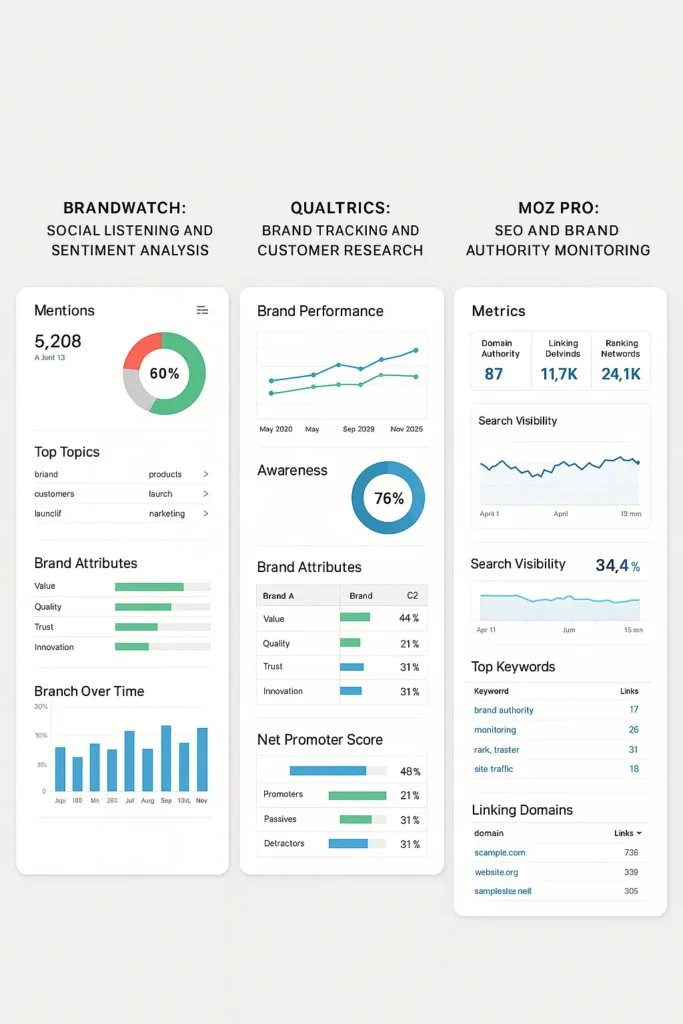
8. Personal Brand Strategy: Building Your Individual Presence
Personal branding isn’t just for influencers and celebrities anymore. Entrepreneurs, executives, and professionals increasingly need strong personal brands to support their business objectives.
Personal brand strategy differs because:
- Authenticity matters more than perfection
- Consistency across platforms is crucial
- Content should provide genuine value
- Networking becomes part of brand building
Your personal brand should complement, not compete with, your business brand. Think of them as different expressions of the same core values and expertise.
9. Brand Strategy for Startups: Getting It Right from Day One
Startups face unique branding challenges: limited budgets, evolving business models, and unproven market fit. But here’s what I’ve learned from working with dozens of startups: investing in brand strategy early is cheaper than rebranding later.
Startup brand strategy priorities:
- Define your « why » clearly: Purpose-driven brands attract better talent and customers
- Stay flexible within boundaries: Establish core elements but allow evolution
- Focus on one audience first: Master one segment before expanding
- Invest in essentials: Logo, website, and basic guidelines come first
- Plan for growth: Choose systems and tools that scale
Services like Looka and Fiverr make professional branding accessible to bootstrapped startups, while platforms like Mailchimp help execute brand communications affordably.
10. Brand Strategy KPIs: Measuring What Matters
You can’t improve what you don’t measure. Brand strategy requires specific metrics that go beyond vanity numbers like followers or impressions.
Key brand strategy KPIs:
| Metric Category | Specific KPIs | Tools to Track |
|---|---|---|
| Brand Awareness | Unaided recall, search volume, social mentions | Google Trends, Brand24, SEMrush |
| Brand Perception | Sentiment analysis, Net Promoter Score, brand association | Qualtrics, Brandwatch, customer surveys |
| Brand Performance | Website traffic, conversion rates, customer lifetime value | Google Analytics, HubSpot, CRM platforms |
| Competitive Position | Share of voice, competitive keywords, market share | SEMrush, social listening tools, industry reports |
Regular measurement helps you understand what’s working and where to adjust your strategy. I recommend quarterly brand health checks to stay on track.
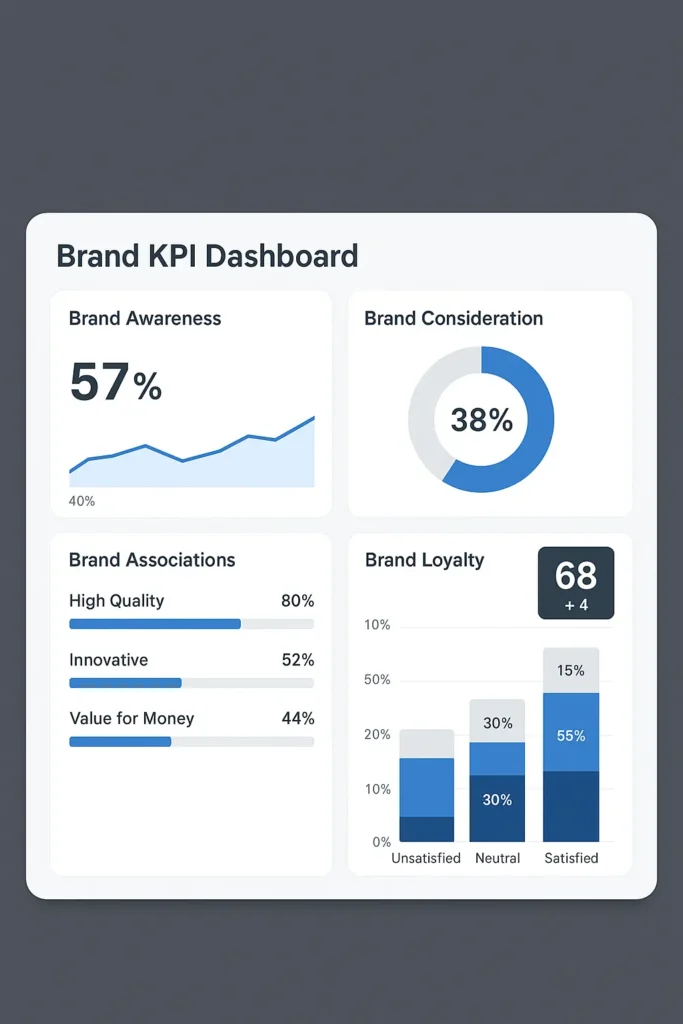
How Brand Strategy Differs from Marketing Strategy
This question comes up constantly, and the confusion is understandable. Think of it this way:
Brand strategy is your long-term vision for how you want customers to perceive and feel about your business. It’s foundational and relatively stable.
Marketing strategy is how you’ll reach and convert customers in the short to medium term. It’s tactical and often changes based on campaigns, seasons, or market conditions.
Brand strategy informs marketing strategy, not the other way around. Your brand positioning, voice, and values should guide every marketing campaign, but individual campaigns shouldn’t change your core brand strategy.
The ROI of Strong Brand Strategy
Let me share some numbers that might surprise you:
- Consistent brand presentation can increase revenue by up to 23% (Lucidpress study)
- 64% of consumers cite shared values as the primary reason for their relationship with a brand (Harvard Business Review)
- Strong brands command average price premiums of 20% or more (Nielsen)
But beyond numbers, strong brands create something invaluable: customer loyalty that survives competitive pressure, market downturns, and business mistakes.
I’ve watched businesses with mediocre products but excellent branding outlast competitors with superior products but weak brand strategies. That’s the power of strategic branding.
Conclusion: Your Brand Strategy Action Plan
Building a powerful brand strategy isn’t about perfect execution from day one—it’s about thoughtful planning and consistent implementation over time.
Here’s your starting point:
- Audit your current brand: What story are you telling now?
- Define your audience: Who are you really serving?
- Clarify your positioning: What makes you different and better?
- Develop your visual identity: Make it memorable and meaningful
- Create brand guidelines: Ensure consistent application
- Implement systematically: Roll out across all touchpoints
- Measure and refine: Use data to improve continuously
Remember, every interaction someone has with your business is a branding moment. Make each one count.
Ready to transform your brand strategy? Start with one element from this guide and implement it completely before moving to the next. Small, consistent steps create big brand wins.
The brands that will thrive in the coming years won’t necessarily be the ones with the biggest budgets—they’ll be the ones with the clearest strategies and most consistent execution.
What will your brand be known for?
Want to dive deeper into brand strategy? Check out these related resources:
